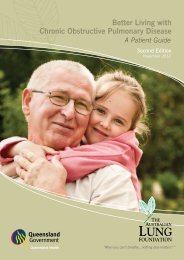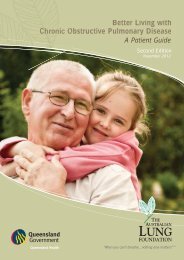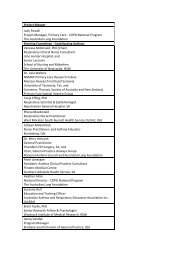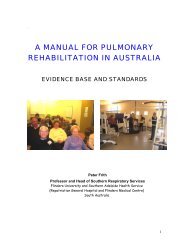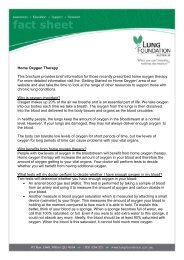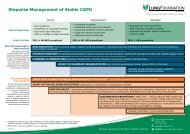view Dr Markos's submission - Lung Foundation
view Dr Markos's submission - Lung Foundation
view Dr Markos's submission - Lung Foundation
Create successful ePaper yourself
Turn your PDF publications into a flip-book with our unique Google optimized e-Paper software.
with a serious lung disorder is estimated at 1 in 5. This is a very highnumber of people at risk. The very young and the elderly are also at ahigher risk.The people who have frequent high exposure to wood smoke include firefightersand residents of regions where wood fuel is commonly used. Theregions most affected by wood smoke are populated inland valleys in thewinter, where residents often heat their homes by burning wood in slowcombustionheaters. The smoke is trapped by temperature inversions inthe valleys so that it lingers close to the ground overnight. There areareas of wood smoke pollution reported in many cities in Australia. Highparticle levels (over 50 µ/m3) were consistently recorded on many winterdays in Launceston, Canberra & Armidale in the 1990’s. The pollutionlevels have improved as residents have switched to alternative homeheating sources, especially electrical. This has been helped byGovernment funded programs which provide a rebate to offset some ofthe costs of buying alternative heaters. Tasmania has the luxury of anenvironmentally friendly electricity supply from hydro- and windgeneratedsources.(c) the standards, monitoring and regulation of air quality at alllevels of government.It is important that the standards for particle pollution and other pollutioncontinue to be set by Environment Australia and that all Australian Statesand Territories adhere to these. This requires daily measurements of themain pollutants, including particles, with appropriate equipment andpersonnel. This information also needs to be made available to the publicpromptly and preferably via a web-based facility to provide continuousaccess. I am aware that there is a process in place for this already via theNEPC of Environment Australia and that annual reports are required fromeach Australian State and the ACT.For Particle Pollution, the Ambient Air Quality NEPM standards are basedon daily PM 10 values. The NEPM re<strong>view</strong> in 2011 recommended that aNEPM standard be introduced for PM 2.5. I support this and, like others, Iwould like to see the current recommendations for PM 2.5 become NEPMstandards. These require that the daily PM2.5 remain below 25 µ/m3 andthe annual daily average below 8 µ/m3.It is useful to continue to set a maximum number of exceedences (eg 5per year) as a guideline, but it is more important to explore the reason foreach exceedence. This is especially important for particle pollution, wherethe response needs to be very different if the exceedences are from homewood heaters compared with exceedences arising from vegetation burnoffsor forestry fires or dust storms. Hence, it is equally important torequest the reporting authorities to include data about the likelyexplanation for each exceedence.




